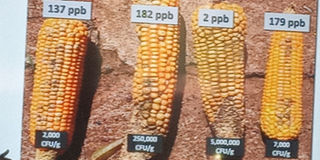Aflasafe: A remedy for aflatoxin contamination

What you need to know:
- A high proportion of maize and groundnuts in Sub-Saharan Africa are contaminated with aflatoxin. The biocontrol methods Aflasafe is a great tool to reduce these mycotoxins.
In sub-Saharan Africa, fungi belonging to Aspergillus class frequently contaminate staple crops such as groundnuts and maize with aflatoxins
The consumption of foods containing high aflatoxin concentrations can have acute health effects, leading to liver cirrhosis or even death while chronic exposure is known to cause liver cancer and is associated with immune system suppression, impaired food conversion, and stunting in children.
Additionally, aflatoxins negatively impact incomes and livelihoods, trade, food security and development.
Scientists contend aflatoxins are resident in the soil meaning farmers must address its existence not only at post-harvest handling stage but right from planting crops which are prone to it.
As such scientists at the National Agricultural Research Organisation (Naro) have been developing a product called Aflasafe to help solve the challenge of aflatoxins.
Development
According to Dr Geoffrey Asea, the director of the National Crops Resources Research Institute (NaCRRI) aflatoxin is prevalent in maize and ground seed especially when farmers mishandle the crops during harvest and storage. It is persistent and difficult to destroy through normal food processing which makes Aflasafe a viable alternative.
It is now 18 years since scientists at the International Institute of Tropical Agriculture (IITA) with partners have been conducting research in developing Aflasafe products.
The scientists identified strains of Aspergillus falvus which do not produce aflatoxin called atoxigenic strains which they used to produce aflasfe.
This product if used in farmers’ fields will help reduce aflatoxins by more than 80 percent right from the soil and the crop as well.
Aflatoxins are naturally occurring compounds that are produced from moulds Aspergillus Flavus and Aspergillus parasiticus. It can be exacerbated when postharvest is not handled well. Once it affects maize grain, one is able to see green spores in the maize and same with groundnut seed thereby causing mould.
Aflatoxin affects three major sectors; public health, food and nutrition and trade.
According records from International Food Policy Research Institute (IFPRI) 3,200 liver cancer cases per year are attributable to aflatoxin exposure (IFPRI) and 40 percent of commodities in local African markets exceed maximum levels in food.
Uganda loses an estimated $38m annually in lost export opportunities because of aflatoxin. In 2018, Kenya rejected 600,000 tonnes of maize from Uganda, equivalent to Shs180b owing to poor quality and aflatoxin contamination.
In livestock, it causes poor milk production, increased morbidity and reduced reproductive success while in poultry, it leads to poor egg production, reduced egg weight and increased mortality.
The Aflasafe technology is existent in the neighbouring countries such as Kenya and Tanzania.
Application of Aflasafe
Aflasafe is a safe and effective natural product for the integrated management of aflatoxin in the maize, sorghum, and groundnut.

Aflasafe dramatically cuts the amount of deadly aflatoxin in food crops, getting it down to zero or to very low levels. Photos | Lominda Afedraru.
Dr Asea explains that the product is in powder form and once it is released, farmers will be expected to mix it in boiled sorghum seed and will be broadcast either in maize or ground farm accordingly.
Using boiled sorghum seed mixture helps to avoid being blown off by wind during broadcasting.
Farmers are expected to apply Aflasafe 2-3 weeks before flowering of the plant at a rate of 10kg per hectare.
Once Aflasafe is broadcast in the field, the spores will be colonised as they drop on the flowers of maize and groundnut to make them clean.
Some of the quantities of Aflasafe will drop in the field and get dissolved in soil to reduce the amount of aflatoxin existing in the soil.
Aflatoxin management
Managing aflatoxin contamination requires integrated approach and this involves creating awareness amongst value chain actors. In the case of agriculture sector integrated pre harvest and post-harvest management is required. Farmers must therefore carry out timely harvest of crops to prevent aflatoxin contamination.
Ensure the crops are properly dried as per the recommendations. Maize, for instance, should be less than 9-13 percent moisture content.
Farmers are advised not to spread the crops to dry on bare soils but instead spread them over tarpaulins or other materials.
During harvesting, farmers should remove the immature pods or cobs damaged by birds or rodents before drying and before storage while storing the harvest crops in a dry cool place and ensure the produce is not left in rain on or attacked by insect pests.




